Textbook Solution: The Earth in Space | IGCSE Cambridge Science for Year 7 - Class 7 PDF Download
| Table of contents |

|
| The Planet and the Solar System |

|
| Tides |

|
| Eclipses |

|
| End of the Chapter Review |

|
| End of the Stage Review |

|
The Planet and the Solar System
Q1. Draw a sketch diagram that shows the force of attraction between a planet and the Sun.
Ans: A simple sketch would show the Sun and a planet with an arrow pointing from the planet to the Sun, indicating gravitational force. This force is directly proportional to the masses involved and inversely proportional to the square of the distance between their centers.
Q2. Which planets are closest to the Earth’s orbit?
Ans: Venus and Mars are the closest planets to Earth's orbit in the solar system.
Q3. Look at the average surface temperatures of the planets.
a) The temperatures of seven of the planets appear to fit a pattern. Which planet appears to have an anomalous temperature (does not fit the pattern)?
b) Describe the pattern of the temperatures of the other seven planets in relation to their distance from the Sun?
Ans :
(a) Venus has an anomalous temperature compared to other planets. Despite being second from the Sun, its thick atmosphere leads to higher temperatures than those of Mercury.
(b) Generally, the further a planet is from the Sun, the cooler its temperature. This trend is due to the decrease in solar radiation received as the distance from the Sun increases.
Q4. The number of moons orbiting each of the outer four planets in the Solar System is much higher than the number of moons orbiting the four inner planets. Suggest a reason why this might be.
Ans: The outer planets, being gas giants, have stronger gravitational fields that can capture more moons. Additionally, their location in the colder outer part of the solar system allows them to retain captured objects more easily than the inner rocky planets.
Q5. Draw a timeline of the discovery of the planets in the Solar System.
Ans: A timeline would start with the ancient known planets visible to the naked eye: Mercury, Venus, Mars, Jupiter, and Saturn. It would then include Uranus (1781), Neptune (1846), and the reclassification of Pluto as a dwarf planet in 2006.
Q6. Use the example of the discovery of Neptune to describe how scientists make predictions and test them against evidence.
Ans: Neptune's existence was predicted based on irregularities in Uranus's orbit, attributed to gravitational perturbations by an unknown planet. Johann Galle observed Neptune in 1846 near the position calculated by Urbain Le Verrier, confirming the predictions based on gravitational theory.
Q7. Explain why it took so long to discover Uranus and Neptune.
Ans: Uranus and Neptune were difficult to discover due to their dimness and slow orbits. Uranus was discovered in 1781 by William Herschel with a telescope, being the first planet discovered with a telescope due to its faint visibility. Neptune's discovery involved mathematical predictions rather than direct observation.
Q8. Which element forms most of the gas in a solar nebula?
Ans: Hydrogen is the most abundant element in a solar nebula, forming the majority of the gas.
Q9. Explain why gravity is so important in the formation of planets. Use a rocky planet as an example.
Ans: Gravity pulls together dust and gas to form larger bodies in the nebula, leading to planet formation. For rocky planets like Earth, gravity caused the accumulation of solid materials, which compacted over time into a planet.
Q10. Figure 11.5 shows the planet Mercury .Each circular feature is a crater , where a piece of work has hit the surface of the planet.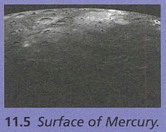 a). What causes rocks to collide with planets?
a). What causes rocks to collide with planets?
b). Explain why this process is important in understanding how rocky planets form.
Ans:
(a) Rocks collide with planets primarily due to gravitational attraction, which pulls space debris like asteroids or comets towards them.
(b) Collisions with rocks and other debris were essential in the early solar system for the accretion of material, contributing to the growth and geological evolution of rocky planets.
Tides
Q1. Draw a diagram to show why there is a high tide at each point of the oceans on Earth every 12 hours, not every 24 hours.
Ans: Tides are primarily caused by the gravitational pull of the Moon on the Earth. The Earth rotates under the tidal bulges caused by the Moon, experiencing high tide at each point as it passes under each bulge. Since the Moon also orbits the Earth, completing one rotation about every 24 hours, it slightly shifts the position of the bulges, resulting in high tides roughly every 12 hours rather than exactly twice in a 24-hour day.
Q2. A person in a small motor boat decides to park it on a beach. They park it low down the beach. Someone passing by tells them it is a bad idea to park it there, because it is low tide. Why is it a bad idea?
Ans: Parking a boat low down the beach during low tide is risky because when the tide comes in, the rising water can either float the boat away, causing it to drift uncontrollably, or it can cause the boat to be flooded if it's not properly secured. Moreover, the incoming tide might bring the boat too close to hazards like rocks or debris.
Q3. Use the orbit of the Moon around the Earth to explain why the time between high tides each day is a little more than 12 hours.
Ans: As the Moon orbits the Earth approximately every 27.3 days, it moves in its orbit about 12 degrees each day relative to the Earth. Due to this movement, the Earth has to rotate a little more than 360 degrees for the same spot to align with the Moon again. Therefore, the time between successive high tides at any given location is slightly more than 12 hours.
Q4. Sketch a copy of figure 11.9. Label them Spring tide and Neap tide. In both diagrams add labels for the phases of the Moon.
Ans: In figure 11.9, panel (a) shows the positions during a Spring tide, where the Sun, Earth, and Moon are approximately aligned (either in a full moon or new moon phase), causing the gravitational forces to combine and create higher high tides and lower low tides. Panel (b) shows the positions during a Neap tide, where the Sun and Moon are at right angles relative to the Earth (during first or third quarter moon phases), which results in weaker gravitational effects and thus lower high tides and higher low tides.
Q5. The Thames Barrier in London, UK is a set of walls that can be raised up to block water from the sea and stop the city from flooding. Why is the barrier used most often when there is a high, spring tide?
Ans: The Thames Barrier is most often used during high, spring tides because these tides are the highest tides, occurring when the Sun and Moon’s gravitational forces align, which significantly raises the water level. This raises the risk of flooding, especially in areas like London where the river tide can lead to severe water level increases.
Q6. Suggest what happens to low tides when the forces of gravity due to the Moon and the Sun are:
a) pulling in the same direction
b) pulling at right angles to each other.
Ans:
a) When the Moon and the Sun are pulling in the same direction (during new and full moons), the low tides are higher than normal because the combined gravitational pull raises the water more than when the Moon is alone.
b) When the Moon and the Sun are pulling at right angles to each other (during the first and third quarters of the Moon), the high and low tides are both less extreme, resulting in less pronounced low tides.
Q7. When predicting the height of high tides and low tides, scientists take the effects of the Moon and the Sun into account. They do not take the effects of other planets into account. Why do you think this is?
Ans: The gravitational influence of other planets on Earth’s tides is negligible compared to the effects of the Moon and the Sun. The Moon’s proximity to Earth and the large mass of the Sun mean that their gravitational forces have a significant impact on Earth’s tides, whereas the further and relatively smaller gravitational influences of other planets produce imperceptible effects on tidal movements.
Eclipses
Q1. Figure 11.13 shows views of two different solar eclipses. Complete the table using the words in the box.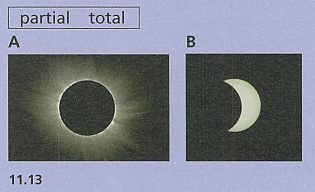

Ans: Picture A is a total solar eclipse. Picture B is a partial solar eclipse.
Q2. Many ancient cultures tried to explain solar eclipses by saying that a huge creature such as a dragon was eating the Sun. Imagine you are trying to explain what really happens during a solar eclipse. Draw a diagram that models the most important points.
Ans: During a solar eclipse, the Moon moves between the Earth and the Sun, blocking the Sun's light from reaching the Earth. This can be modeled by placing three objects in a straight line with the Moon in the middle.
Q3. Remember how astronomers predicted the position of Neptune, and how people can predict tides. Astronomers can predict accurately the dates, times and places where solar eclipses can be seen, for many hundreds of years in the future. Suggest what information an astronomer needs to make these predictions.
Ans: Astronomers need information about the orbits of the Earth and Moon, as well as their positions relative to the Sun. They also require historical data on previous eclipses to create accurate models and predictions.
Q4. What colour will the Moon sometimes appear during a lunar eclipse? Choose one word from the box.
Ans: The Moon will sometimes appear red during a lunar eclipse.
Q5. True or false? Looking directly at the Moon during a lunar eclipse can damage your eyes.
Ans: False. It is safe to look at the Moon during a lunar eclipse.
Q6. Describe the difference in the position of the Moon between a solar eclipse and a lunar eclipse.
Ans: In a solar eclipse, the Moon is between the Earth and the Sun, blocking the Sun's light. In a lunar eclipse, the Earth is between the Sun and the Moon, and the Earth's shadow falls on the Moon.
Q7. Suggest a reason why solar eclipses last only a few minutes whereas lunar eclipses last a few hours.
Ans: Solar eclipses last only a few minutes because the Moon's shadow on the Earth is very small, so it moves quickly across the Earth's surface. Lunar eclipses last longer because the Earth's shadow is larger, and it takes longer for the Moon to pass through it.
End of the Chapter Review
Q1. Planets in our Solar System consist of:
a) only solids
b) only solids or liquids
c) only solids or gases
d) solids, liquids or gases
Ans: d) solids, liquids or gases
Q2. The Solar System is thought to have formed from:
a) a large amount of rock breaking apart
b) a solar nebula of gas and dust
c) two stars colliding
d) a collapsing galaxy
Ans: b) a solar nebula of gas and dust
Q3. At a particular place on Earth, a high tide occurs:
a) about every 6 hours
b) about every 8 hours
c) about every 12 hours
d) about every 24 hours
Ans: c) about every 12 hours
Q4. The main reason for tides occurring in Earth’s oceans is the force of gravity due to:
a) the Sun
b) the Earth
c) the Moon
d) the other planets
Ans: c) the Moon
Q5. This picture shows the view half way through an eclipse. What type of eclipse does this picture show?
a) partial solar eclipse
b) partial lunar eclipse
c) total solar eclipse
d) total lunar eclipse
Ans: d) total lunar eclipse
Q6.
(a) Describe the two main types of planet found in our Solar System.
(b) Name two ways that teams of scientists can make detailed observations of the other planets in our Solar System.
Ans:
(a) The two main types of planets are terrestrial planets, which are small and rocky, and gas giants, which are larger and composed mostly of hydrogen and helium.
(b) Scientists use space telescopes and spacecraft missions to make detailed observations of other planets.
Q7.
(a) Describe how you can observe high tide and low tide on a beach.
(b) How long would you need to stay on a beach after high tide to observe low tide?
Ans:
(a) You can observe high tide and low tide by noticing the highest and lowest points that the sea reaches on the beach over a period of time.
(b) About six hours.
Q8. Look at figure 11.17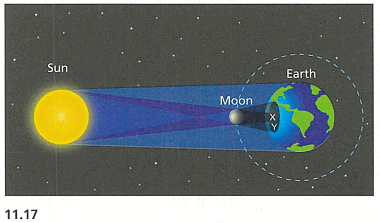
Complete the following sentences using the words from the box.
A person standing at point X will see a ____________ eclipse.
A person standing at point Y will see a ____________ eclipse.
Ans:
A person standing at point X will see a total solar eclipse.
A person standing at point Y will see a partial solar eclipse.
Q9.
(a) Sort the following objects from our Solar System in order of their size (smallest to largest): Jupiter, Sun, Moon, Earth.
(b) Describe how scientists think the Sun formed.
(c) Describe how scientists think the planets formed.
Ans:
(a) Moon, Earth, Jupiter, Sun
(b) Scientists think the Sun formed from a cloud of gas and dust that collapsed under its own gravity and began to fuse hydrogen into helium.
(c) Scientists think the planets formed from the leftover gas and dust around the newly formed Sun, clumping together over time through collisions and gravity.
Q10.
(a) Describe four differences between the planets Mercury and Jupiter.
(b) Scientists have collected large amounts of data about all the planets in the Solar System. Describe two ways they have used to collect this data.
(c) How can observing other stars help tell us the way our Solar System formed?
Ans:
(a) Mercury is small, rocky, and has no atmosphere, while Jupiter is large, mostly gaseous, and has a thick atmosphere with strong storms. Mercury has no moons, while Jupiter has many. Mercury orbits close to the Sun, while Jupiter orbits much farther away.
(b) They have used spacecraft to fly by, orbit, or land on planets and telescopes positioned in space and on Earth to observe the planets.
(c) Observing other stars and their forming planetary systems can help us understand the processes and conditions that are typical in the formation of solar systems, including our own.
Q11. The table records the observed height of the sea up a harbour wall over 24 hours.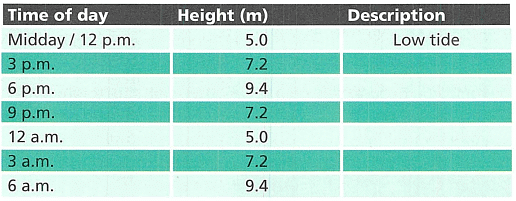 (a) Copy the table. Write the terms 'low tide' and 'high tide' at the correct time.
(a) Copy the table. Write the terms 'low tide' and 'high tide' at the correct time.
(b) Describe the observations and explain why the Moon causes these changes in height.
Ans :
(a) Time of day: Midday / 12 p.m., Height (m): 5.0, Description: Low tide; 3 p.m., Height (m): 7.2, Description: High tide; 6 p.m., Height (m): 9.4, Description: High tide; 9 p.m., Height (m): 7.2, Description: Low tide; 12 a.m., Height (m): 5.0, Description: Low tide; 3 a.m., Height (m): 7.2, Description: High tide; 6 a.m., Height (m): 9.4, Description: High tide.
(b) The gravitational pull of the Moon on the Earth's oceans causes the water to bulge out in the direction of the Moon and on the opposite side, creating high tides. As the Earth rotates, the locations of these bulges change, leading to the cycle of high and low tides observed.
Q12. The following sequence of pictures shows how the view through a telescope changes during an eclipse. (a) What type of eclipse do these pictures show?
(a) What type of eclipse do these pictures show?
(b) The unit of time has been left off the diagram. Suggest which unit from the following box would be correct. (c) Draw a diagram of the Sun, Earth and Moon to show how this type of eclipse occurs.
(c) Draw a diagram of the Sun, Earth and Moon to show how this type of eclipse occurs.
(d) Mark a point on your diagram to show where on Earth the photographer might have been standing.
Ans(a) : Total solar eclipse
Ans(b) : Minutes
Ans(c) : 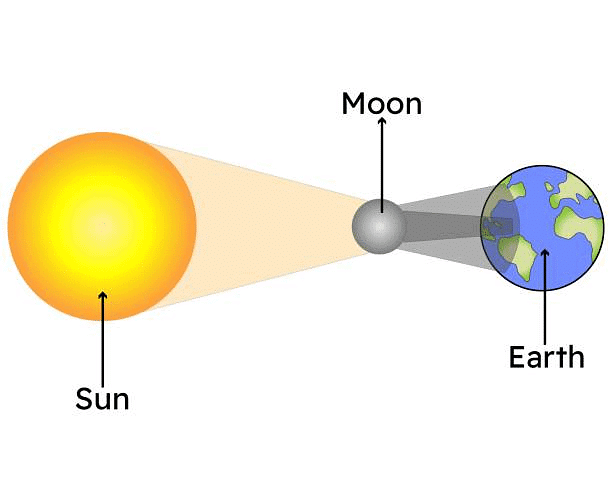
Ans(d) :
Q13.
(a) Explain why Europa orbits Jupiter.
(b) Would you expect there to be tides on Europa? Explain your answer.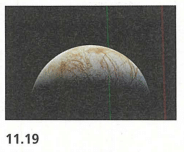
Ans:
(a) Europa orbits Jupiter because it is gravitationally bound to it as one of its moons.
(b) Yes, tides on Europa are expected due to the gravitational influence of Jupiter, which, being massive, can create significant tidal forces on Europa, possibly contributing to its geological activity.
Q14. The following diagram shows the area on Earth from which a solar eclipse will be visible in 2023.
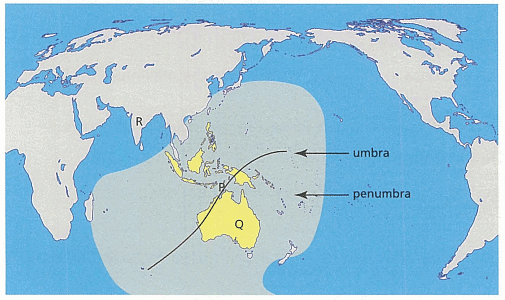 (a) Write a single sentence that describes what happens to the positions of the Earth, the Moon and the Sun during a solar eclipse.
(a) Write a single sentence that describes what happens to the positions of the Earth, the Moon and the Sun during a solar eclipse.
(b) People standing at points P, Q, and R. Describe what each person will see during the eclipse.
Ans:
(a) During a solar eclipse, the Moon passes between the Earth and the Sun, blocking the Sun's light and casting a shadow on the Earth.
(b) Person at point P will see a partial eclipse, person at point Q will experience a total eclipse, and person at point R will see a partial eclipse.
End of the Stage Review
Q1.
(a) The oceans on Earth experience tides. Select the two correct statements.
a) There is one high tide every day.
b) There are two high tides every day.
c) The main reason for high tides is the force of gravity due to the Sun.
d) The main reason for high tides is the force of gravity due to the Moon.
Ans:
b. There are two high tides every day.
d. The main reason for high tides is the force of gravity due to the Moon.
(b) The table shows sea level as measured on a harbour wall. (i) Using only the data in the table, write down the maximum (highest) sea level reached during July.
(i) Using only the data in the table, write down the maximum (highest) sea level reached during July.
(ii) State the date in July when the largest range of sea level occurs.
(iii) Complete the following sentence. The largest range of sea level occurs when there is a _______ tide.
(iv) Explain what causes the largest range of sea level to occur.
Ans: The maximum sea level reached during July was 5.6 meters on July 11th.
Ans: The largest range of sea level occurs on July 11th.
Ans: The largest range of sea level occurs when there is a spring tide.
Ans: The largest range of sea level occurs due to the alignment of the Earth, the Moon, and the Sun, which enhances the gravitational pull on the oceans, resulting in higher high tides and lower low tides, known as spring tides.
Q2. The diagram shows a boundary where two parts of the Earth's crust are colliding .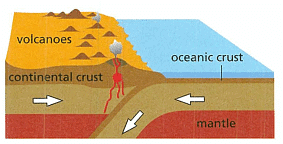
(a). What name is given to these moving parts of the Earth's crust?
Select the correct answer.
a) Fold mountains
b) Sedimentary rocks
c) Continents
d) Tectonic plates
Ans: d. Tectonic plates
(b) It is less safe to live in the area labelled X compared to a place away from the boundary. Give two reasons why it is less safe.
Ans: It is less safe because of the increased likelihood of volcanic eruptions and earthquakes, which are more common near tectonic boundaries.
(c) Describe what happens at a different kind of boundary where parts of the Earth's crust are moving apart.
Ans: At boundaries where the Earth's crust is moving apart, such as at mid-ocean ridges, magma rises from the mantle to fill the gap, creating new oceanic crust.
Q3.
(a) The eight planets in our Solar System are Earth, Jupiter, Mars, Mercury, Neptune, Saturn, Uranus and Venus. Name the planet that is closest to the Sun.
Ans: Mercury
(b) The table shows data for three planets: A, B and C. Write the letter of the planet that is furthest from the Sun.
Write the letter of the planet that is furthest from the Sun.
Ans: B (Neptune)
(c) Copy and complete this sentence. A solar eclipse occurs when light from the _______ is blocked by the _______.
Ans: A solar eclipse occurs when light from the sun is blocked by the moon.
Q4. The diagram shows a process that occurs on Earth.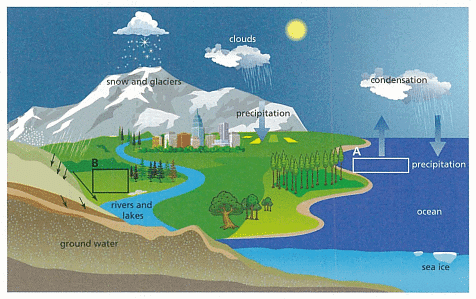 (a) Name the process that this diagram models.
(a) Name the process that this diagram models.
Ans: The water cycle
(b) Add the two missing labels A and B to the diagram.
Ans: A - Evaporation, B - Infiltration
(c) This process has only been observed on Earth. What does this tell us about the other planets in the Solar System?
Ans: It indicates that other planets in the Solar System lack the necessary conditions, such as atmospheric pressure, temperature, and liquid water, to support the water cycle as it occurs on Earth.
|
32 videos|61 docs|22 tests
|
FAQs on Textbook Solution: The Earth in Space - IGCSE Cambridge Science for Year 7 - Class 7
| 1. What causes tides on Earth? |  |
| 2. How do eclipses occur? |  |
| 3. What is the significance of the solar system in relation to the Earth's position in space? |  |
| 4. How do tides impact marine life and coastal areas? |  |
| 5. What is the importance of understanding the Earth's position in space for scientific research and exploration? |  |















